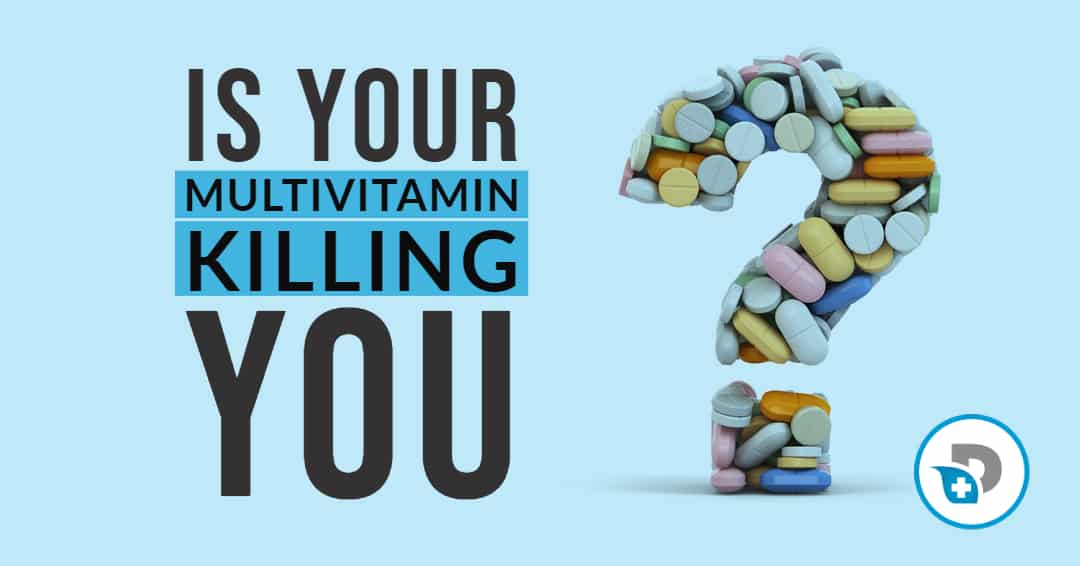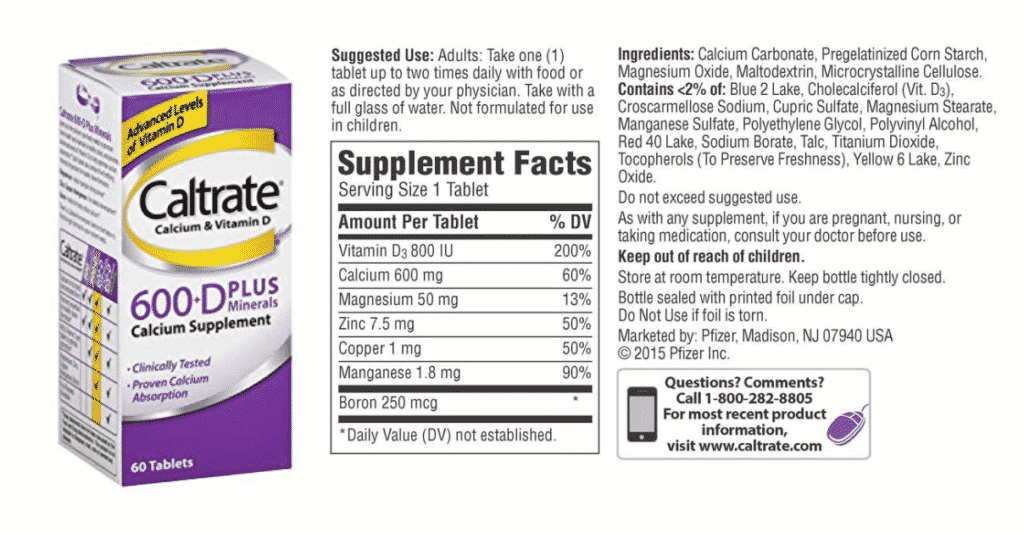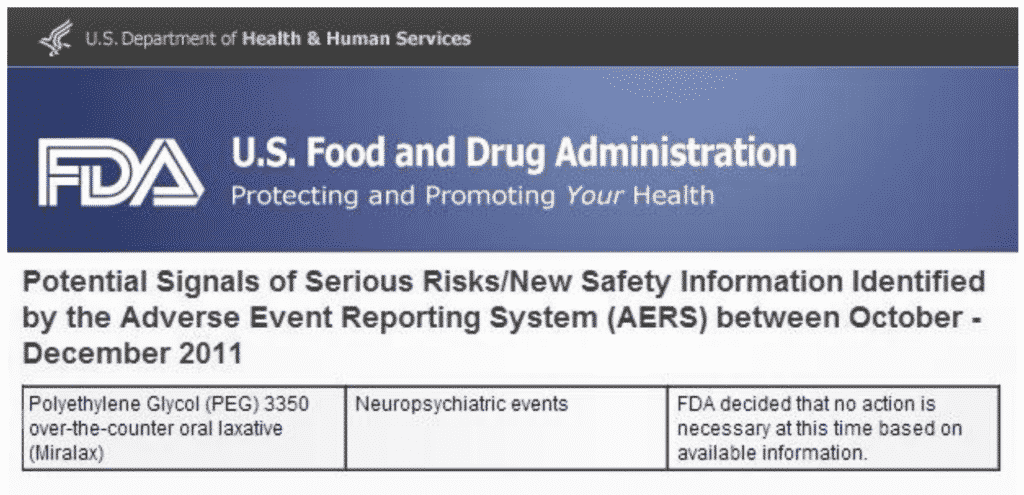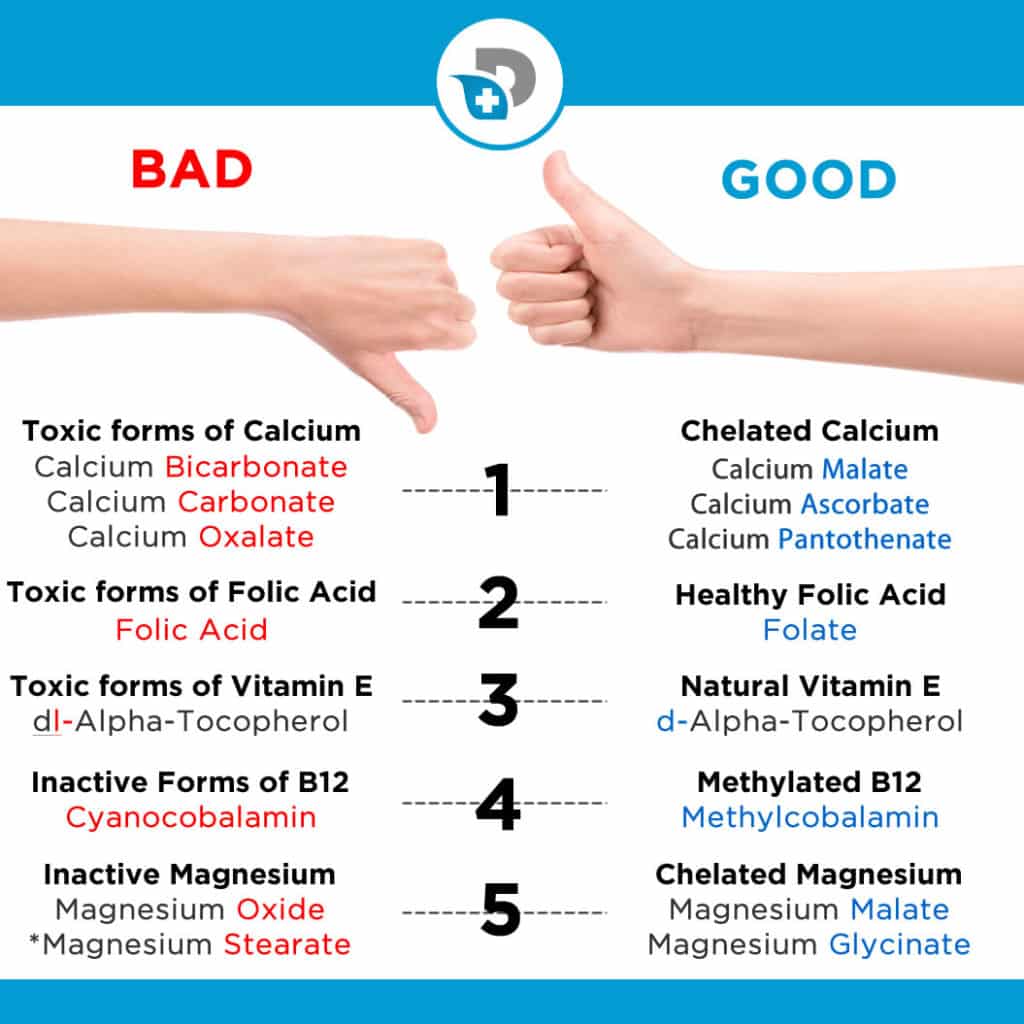Is Your Multivitamin Killing You?
- by Dr. Daniel
- Published on

Read This if You Currently Take a Multi-Vitamin Purchased from the Grocery or Health Food Store…
Is Your Multivitamin Healthy?
Are you 100 percent certain that the multivitamin you’re taking is healthy?
Do you know what to look for when searching for a good multivitamin?
Can you tell the difference between the types of vitamins that your body will absorb and those types that simply pass through or worse, cause damage to your body?
If the answer is NO, I don’t blame you.
There’s so much confusion and misinformation about what the best multivitamin and supplements are, that even most health-food store owners don’t have a clue.
Here are a few questions that need to be answered when considering multivitamins.
- Is a multivitamin necessary if you already eat a whole-foods diet?
- Is your multivitamin sourced from real food or is it synthetic?
- Does your multivitamin contain exactly what it claims in the label?
- Do better multivitamins cost more?
- Does your multi contain the right kind of vitamins that your body will absorb?…or are you simply peeing your money away?
- Do you trust the company that your buying your vitamin from?
The last question is actually the most important because of how corrupt the food-and-supplement industry have become.
Do you remember Larabar, the three- to four-ingredient raw-food bar?
Well, they sold out to General Mills, the maker of Cheerios and other packaged garbage.
Burt’s Bees, they sold out to Clorox.
And more recently, New Chapter, once a great multivitamin provider, was acquired by Procter and Gamble, the same company that brings you Tide, Pringles potato chips, and whose CFO, Jon Moeller, is the very same man who sits on the board of directors of Monsanto, the most criminal of all food conglomerates.
As you can see, purchasing products and especially those products that are supposed to be healthy, is not as simple as it may seem.
So What Do You Do?
You start off by being well-informed and being able to distinguish between good and bad multivitamin supplements on the market.
That’s exactly what we will be discussing in this article.
Most Multivitamins Are Full of Garbage
Please make note that I am not here to discredit multivitamins.
I believe the right type of multivitamins serve a great purpose and can help to improve overall health and wellness way beyond what most people give credit for.
However, too many people are buying the wrong multivitamins and inadvertently contaminating their own body.
A 2008 study funded by the FDA found that many brands of multivitamins are contaminated with lead.
In many cases, the levels of lead were very close to the tolerable limits for humans.
More shocking, was that of the 300-plus children’s vitamins and prenatal vitamins tested for lead, only 4 were found to be lead-free!
ConsumerLab.com – a vitamin and supplement watchdog that independently evaluates products that affect health and nutrition – tested 38 leading multivitamin/mineral products sold in North America.
They focused their testing on a number of vital nutrients including folate, calcium, vitamin C and D.
Here’s a few of the findings…
- 46% of the multivitamins selected for testing failed testing for not meeting quality specifications
- Most gummy formulations did not contain the listed amounts of nutrients
- 13 of the 38 multivitamins selected for testing failed to get approval
- Some had lower levels of nutrients than the label claimed to have while others had higher (toxic) amounts
Here’s a small list of multivitamin/minerals that came up containing FEWER nutrients than stated on the label:
- Alpha Betic
- Schiff Single Day
- Country Life Maxi-Sorb Max for Men
- Trader Joe’s Vitamin Crusade
- Juice Plus + Garden Blend
- Melaleuca Vitality Multivitamin & Mineral
- All One Active Seniors
Sadly, it tells us that we can never really know what’s in the supplements we think we are taking.
Unless of course you have access to labs and conduct the testing yourself.
What do you do?
The Basics of Choosing The Best Multivitamin
First off, the same rules apply when picking food.
Read the entire label and pay attention to the supplement facts as well as ingredients.
The obvious stuff should be identified immediately.
For example, the 3rd ingredient in Caltrate Plus Calcium and vitamin D supplements is maltodextrin (a sugar or form of sweetener), followed by Blue 2 Lake, Red 40 Lake, Yellow 6 Lake and even Polyethylene Glycol (What the heck is that?)

Polyethylene glycol is made by stringing together molecules of ethylene glycol into a large polymer chain, hence the prefix “poly-” which is Greek for many.
On its own, ethylene glycol is used in automotive antifreeze and brake fluid.
BUT…. And this is a very BIG BUT…
According to the National Institute for Occupational Safety and Health, it is an extremely toxic substance:
“Ethylene glycol is chemically broken down in the body into toxic compounds. It and its toxic byproducts first affect the central nervous system (CNS), then the heart, and finally the kidneys. Ingestion of sufficient amounts [as little as 30 ml ] can be fatal.”

Shut the FRONT DOOR!
Yup, giving grandma Calcium pills that contain Polyethylene Glycol could be making her psychotic or at the least contributing to heart and kidney problems.
The first ingredient in Centrum chewable multivitamins is sucrose (sugar).
Dumb.
The first ingredient in Vitafusion’s ‘weight management fiber gummies‘ is polydextrose, a synthetic fiber additive, followed by natural flavors and sucralose (aka Splenda – a compound suspected to act as a neurotoxin).
More Dumb.
The first ingredient in CVS brand chewable vitamin C is—you guessed it—sugar.
The Most Dumb.
Get the idea?
Your multivitamin should not have sugar!!!
It also should be FREE from artificial colors, flavors or potential psychotics.
If the vitamin you are considering lists artificial colors, a color followed by a number or something like “FD&C Yellow 5” then put it back on the shelf or trash it.
It’s garbage.
It also should not contain milk, soybean or wheat.
MOVING ON…
Keep in mind that 1,000 mcg (microgram) is the same as 1 mg (milligram), and 1,000 mg = 1 mg.
IU stands for International Units and is used for certain ingredients measured by their activity rather than weight.
The FDA requires that all companies place the percent of the Daily Value for vitamins and minerals.
But daily values are misleading and honestly not standardized.
It would take a series of textbooks to teach you this, but what you want to pay attention to is not the DVs or daily values, but the Recommended Dietary Allowances (RDAs), Adequate Intakes (AIs) and the Tolerable Upper Intake Levels (ULs).
These values (RDA, AI and UL) are known as Dietary Reference Intakes and based on an individual’s current level of health and needs and truly should be decided by a qualified healthcare professional.
RDA is the average daily intake level thought to be sufficient to meet the nutrient requirements of nearly all healthy individuals.
Again, this is an average.
AI or adequate intake is used when there is not sufficient information to determine the RDA.
Finally, A Tolerable Upper Intake Level (UL) is the highest level of daily intake of a nutrient that is likely to pose no risk of adverse health effects for most people.
This of course is highly opinionated among nutritional experts and dependent on the individual’s age, gender and general health.
Below I will share with you a few things that I look for when selecting vitamins that I know every single person on the planet should be supplementing with, along with a balanced diet.
How to Pick a Multivitamin that Doesn't Poison You
Every day, millions of people take their multivitamin assuming that it’s doing their body good.
And they would be right – if they were taking the right multi.
Just like processed foods can lead to disease and dysfunction of the body, processed multivitamins are just plain crap that can do the same.
What’s worse is that they are actually sold in “health food” stores giving the illusion that they’re healthy.
I'll never forget the time when I was working in a research lab and a fellow scientist showed me the devastation of synthetic vitamins.
Specifically, our lab was studying how various compounds affected DNA, nerves and the mechanisms of pain.
And one day as my partner worked feverishly next to me, he quickly called me over to have a look and what was happening to DNA strands in a petri dish exposed to synthetic vitamins.
Resting under the high powered microscope was a petri dish that contained DNA that looked as if it had been blown to bits by a nuclear war head.
In this case, the nuclear war head was a synthetic vitamin.
My lab partner had been exposing DNA to various compounds and one of them was Cyanocobalamin, a form of synthetic B12 commonly found in multi-vitamins.
His intentions were to mimic vitamin consumption and observe the results.
What he found was that Cyanocobalamin caused the chromosomes of DNA to scatter and become unorganized.
Basically he demonstrated how synthetic B vitamins could blow up the genetic map of DNA.
On the other hand, when DNA was exposed to Methylcobalamin (the more biologically activated form of B12), the DNA remained preserved.
This is not the first time that Cyanocobalamin was found to be dangerous.
Studies previously identified problems of toxicity including the promotion of cell death. [1]
The question you should be asking yourself right about now is, “How can the FDA or private vitamin manufacturers be allowed to sell these toxic vitamins?”
First, this is not going to turn into a “Conspiracy Theory” article, but there’s
certainly some fishy stuff happening:
The results of sponsored studies in major medical journals almost invariably
benefit the sponsor (often large corporations).
In fact, the conflicts are so blatant that I can often guess from reading an abstract who the study’s sponsor must be.
For example. In the leading nutrition research journal: American Journal of Clinical Nutrition, 7 of the 12 members of the editorial board list major corporate affiliations.
The list of food companies for which they consult or advise is too long to reproduce but it includes Coca-Cola, PepsiCo, The Sugar Association, The National Restaurant Association, ConAgra, McDonald’s, Kellogg, Mars, and many others. [2]
Think the information that gets out to the public is biased?
Unfortunately, Cyanocobalamin isn’t the only toxic offender.
I can guarantee you that most store bought multivitamins are loaded with synthetic, counterfeit compounds.
Even “health practitioners” and so called “vitamin gurus” are unaware of the real and present danger of taking these substances and they continue to push them on consumers who become another “casualty of war”.
I’m committed to educating you as much as possible on nutrition, vitamin therapy and the horrors of synthetic foods as well as vitamins.
If they’re synthetic, they don’t belong in your body – they belong in the trash!
Why Synthetic Vitamins Should Be Avoided
Let's talk for a moment about why synthetic vitamins should be avoided.
Fake Folic Acid
First, there's folic acid, which is a cheap counterfeit isolate of the natural “folate” vitamin.
The term folate (not to be confused with folic acid) encompasses many naturally occurring chemical cousins – known to scientists as isomers – that play a wide range of positive roles in the body.
The pharmaceutical industry went straight up gangster with respect to Folic acid.
In fact, they have convinced just about every woman out there that Folic Acid is the most important nutrient prior to getting pregnant.
Just to be clear – it is very important to increase “FOLATE” levels prior to getting pregnant, but you should not be doing it with “FOLIC ACID” supplements.
Pteroylglutamic acid monoglutamate, more commonly known as the drug Folic Acid has made its way into multivitamins and prenatals everywhere.
The problem is that researchers are finding that women in the top quarter of folic acid consumption experience higher incidences of colorectal cancer. [3]
Making matters worse, the FDA mandated that grain based foods such as bread and cereal be fortified with folic acid in 1996.
BASICALLY THOSE IDIOTS INTENTIONALLY ADDED A DRUG (POISON/TOXIN) TO COMMON FOOD PRODUCTS!
Sadly, they left out the warning labels informing us about all the side effects.
According to the FDA, “no long term studies exist to evaluate the risks associated with prolonged use.” of folic acid.
YET, The Prostate, Lung, Colorectal and Ovarian (PLCO) Cancer Screening trial linked folic acid intake with 20% to 32% increased risk of breast cancer in women!!! [4]
Fake Vitamin B12
There are two forms of vitamin B12 that you’re likely to come across – methylcobalamin and cyanocobalamin.
Methylcobalamin is good and cyanocoblamin is bad.
What’s the problem with Cyanocobalamin?
The two different B12 forms are very similar, and the only chemical difference between them comes down to one small part of the molecule, where the names give it away: where methylcobalamin has a methyl group (just carbon and hydrogen), cyanocobalamin has a cyanide group.
And obviously cyanide isn’t something you normally expect or want to find lurking in your multivitamin.
So why do pharmaceutical companies use cyanocobalamin in the first place?
Why does it ever appear in multivitamins, and why do so few people know about the better alternative?
The answer is predictably disappointing: money.
Synthesizing the unnatural cyano- form is far cheaper than making or obtaining methylcobalamin, and most of these businesses are more focused on increasing their profits than making sure you get the best possible supplementation.
Although the amount of cyanide in cyanocobalamin isn’t going to kill you, there is data suggesting that Cyanocobalamin prevents the body from using methylcobalamin (B12) and results in cytotoxicity (cell toxicity) potentially causing cell death. [5] [6]
Fake Calcium Supplements
All this gets worse…
Another commonly used supplement that does more harm than good is calcium.
Practically EVERYONE has been fooled into thinking this one is not only safe, but mandatory for healthy bones.
How many women do you know who are concerned with calcium?
While in Chiropractic school, I remember having a friend who shared a horrific death of someone close to him.
Basically the deceased had been a “health nut,” taking calcium as prescribed by her doctor.
The woman was found dead lying on the kitchen floor and upon her autoposy it was found that her arteries were “calcified” literally to the point where they were frozen.
Like concrete, her insides hardened.
According to the doctor who performed the autopsy, the calcium was the catalyst for her death.
You see, there’s a HUGE difference between calcium from nature – which is organic calcium – and the poisonous calcium that’s is in your multi-vitamin!
Produced by drug giants Hoffmann-La Roche and BASF, calcium in your multivitamin is known chemically as:
- Calcium oxide
- calcium carbonate
- calcium citrate
- dolomite
- di-calcium phosphate
- calcium hypochlorite
- tri-calcium phosphate
A 2007 study published in the American Journal of Clinical Nutrition found that calcium supplements don’t reduce fracture rates in older women, and may even increase the rate of hip fractures. [7]
Beyond being ineffective for bone health, calcium supplements are associated with some pretty serious health risks.
A meta-analysis of studies involving more than 12,000 participants also published in BMJ found that calcium supplementation increases the risk of heart attack by 31%, stroke by 20% and death from all causes by 9%. [8]
I can guarantee you this is because most people are supplementing with the wrong form of calcium!!!
My list of acceptable calcium supplements include:
- Dicalcium Malate
- Calcium Ascorbate
- Calcium Pantothenate
Bottom line: If you value your health, examine your multi-vitamin labels. If you find any of the forms of synthetic calcium listed above, then throw the bottle in the garbage!
5 Steps to Picking the Right Vitamin
There are a few ways that you can quickly identify fake, synthetic vitamins from high quality, healthy vitamins.
Of course, this has to do with reading the labels.
I’ll tell you right now, your vitamin should not contain any sugars, artificial colors, sweeteners or preservatives.
Also look at the label for the following:
- Calcium (Oxalate, Carbonate, Phosphate)
- Folic Acid
- DL-Alpha-Tocopherol (synthetic vitamin E)
- Cyanocobalamin (B12)
- Magnesium Stearate
- Chromium Picolinate
If it contains any of the above, then I am telling you right now to throw those vitamins in the trash!
In addition to wasting your money, they’re destroying your health.
All the supplements that I listed above are imposters.
They’re made in a lab just like processed foods. Look at the charts below to help you understand more:

